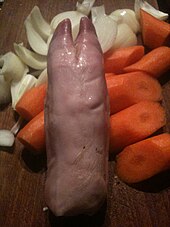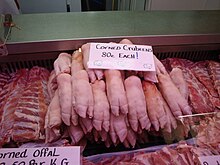| This article contains promotional content. Please help improve it by removing promotional language and inappropriate external links, and by adding encyclopedic text written from a neutral point of view. (July 2024) (Learn how and when to remove this message) |

A pig's trotter, also known as a pettitoe, is the culinary term for a pig's foot. It is used as a cut of pork in various dishes around the world, and experienced a resurgence in the late 2000s.
Description


Before sale, the trotters are cleaned and typically have the hairs pulled with a hot tank and beaters. They are often used in cooking to make stocks, as they add thickness to gravy, although they are also served as a normal cut of meat. In Puerto Rico, a tomato-based stew of pigs' trotters with chickpeas is called patitas de cerdo. Sometimes potatoes or butternut are added. Chef Marco Pierre White has long served trotters at his restaurants, based on the original recipe of mentor Pierre Koffmann. In the New York City restaurant Hakata Tonton, 33 of the 39 dishes served contain pigs' trotters.
Following the Great Recession, there was a boom in popularity of pigs' trotters in the United Kingdom as a revival in cheap meat recipes occurred. In 2008, British supermarket Waitrose reintroduced trotters to its stores, and found that they quickly became popular. In 2009, Pierre Koffmann set up a pop-up restaurant, and found that diners ate an entire month's stock of 500 pigs' trotters in less than a week.
In Norwegian tradition, pigs' feet are salted and boiled and served as syltelabb. This is a pre-Christmas dish because the pig was slaughtered before Christmas, and everything was used. Today syltelabb is for enthusiasts.
Recipes and combinations


- Bean crock (les pais au fou) in Jersey, Channel Islands
- Batsoà from the Piedmont region of Italy
- Cappello da prete in Modena, Italy
- Chispalhada in Portugal: trotter with chickpeas or beans
- Cotechino in Modena, Italy
- Körömpörkölt in Hungary
- Crubeens in Ireland
- Pied de cochon in Sainte-Menehould, France
- Tebichi in Okinawa, Japan
- Tom tin moo in Laos
- Crispy pata, Paksiw na pata, and patatim in the Philippines
- Zampone in Modena, Italy
- Manitas de cerdo in Spain
- Jokbal in Korea
- Patitas de cerdo en escabeche and manitas de cerdo en salsa verde o salsa roja in Mexico
- Souse in Barbados and St. Vincent and the Grenadines
- Spitzbein or Pfoten in German, known as golonka in Polish
- Syltelabb, a traditional Norwegian dish
- Inkokta grisfötter, a traditional Swedish dish similar to Syltelabb
- Kha mu, lit. "pigs' feet" in Thailand influenced by Chinese stewed pork
- Patitas con maní and Sarza de patitas in Peru
- Peus de porc in Catalonia
See also
References
- "Pettitoes Definition". Merriam-Webster Dictionary. Retrieved 29 May 2016.
- ^ Carmichael, Sri (21 October 2009). "Pig's trotters fly off the shelves as customers seek cheap meat cuts". The Evening Standard. Archived from the original on 24 October 2009.
- ^ Heath, Adrian (30 October 2009). "A modern bargain: Pig's Trotters". BBC News.
- ^ Wallop, Henry (21 September 2008). "Credit crunch sees Bath chaps, ox cheek and pigs trotters return". The Telegraph.
- Cooke, Rachel (20 June 2010). "Pierre Koffmann: 'Not enough British chefs cook from the heart'". The Guardian.
- MacDonald Smith, Fiona (3 March 2008). "Pigs' feet: the new superfood". The Telegraph.
- https://thornews.com/2011/12/31/syltelabber-pickled-pigs-feet/ thornews
- Carvalho, Mónica (20 October 2020). "Chispalhada: um prato para estômagos aventureiros" [Chispalhada; a dish for adventurous stomachs]. Ekonomista (in Portuguese).
- Acurio, Gastón (2008). Larousse de la gastronomía peruana: diccionario gatronómico ilustrado (in Spanish). Lima: Q.W. Editores. p. 293. ISBN 9789972589379.
- "Una delicia del Cusco, sarza de patas de cerdo". Cuzco Eats (in European Spanish). 9 January 2018. Retrieved 23 August 2019.
- "¿Cómo se prepara las patitas con maní? Aquí te enseñamos". wapa.pe. Retrieved 23 August 2019.
